This article is part of our body language guide. Click here for more.
Did you know legs can tell you if someone is attracted to you? If they’re feeling anxious, or happy, or even telling a lie?
Most people pay attention to the face to find these emotions, but rarely do they look any lower than that!
But here’s the simple truth:
Legs often communicate feelings BETTER than the face.
In this article, I’m going to teach you 20 leg cues that’ll reveal a person’s hidden emotions, including:
- The #1 leg cue that is the most common in prolific liars
- The sitting position you should NEVER do in front of your boss (unless you’re about to quit!)
- Why men sit with their legs open, and women sit with their legs crossed
- The sexiest way a woman can pose her legs (as voted by 86% of men!)
Strap in, because what I’m about to teach you will get you a “leg” up in all your social interactions!
Before you go further, take our body language quiz to test your nonverbal skills!

Can You Read Body Language?
How good are your body language skills? Take our free body language quiz to find out!
How to Use Your Legs to Look Confident
Can you tell which of these images gives the most confidence cues?

If you want to look confident and avoid spaghetti legs, I want you to think of your legs in shapes.
Try to keep your legs in a V-shape to display confidence.
You can also keep them in a smaller V to remain neutral.
Legs that look like two l shapes might mean you are too stiff.
And the X shape? That’s a naturally closed-off position.
There are exceptions which we’ll cover below, but keep these shapes in mind when trying to look confident!
Keep your legs in a V shape to display confidence.
Positive Leg Cues
Let’s start with the positives. Positive leg cues will usually indicate one or more of the 3 C’s:
- Confidence
- Comfort
- Chemistry
Keep an eye out for these cues; they are usually a good sign if you see them!
Seated parallel legs

Want to know one of the sexiest cues of all? The seated parallel legs cue. This is when a woman crosses her legs and relaxes one leg on top of the other, highlighting that calf muscle and giving the appearance of higher muscle tone1https://www.nytimes.com/1970/05/31/archives/the-way-we-speak-body-language-the-way-we-speak-body-language.html. Alternatively, the legs might be placed to one side and uncrossed.
Emma Watson does it:

Claire Danes does it:

And Sofia Vergara does it:

What it Means: The most eye-catching of all leg postures, this leg cue is primarily done by women (for obvious reasons!) and gives off strong sex appeal and attraction.
In one survey, 86% of male participants voted Seated Parallel Legs as the most attractive female sitting position2www.amazon.com/Definitive-Book-Body-Language-attitudes/dp/140916850.
Women may do this with or without knowing. And if it’s on a date, this is a good sign she’s trying to get your attention!
How to Use it: For women, sit with this posture when you want to ramp up your sex appeal and gain attention.
Swinging
We’ve all done this one as a kid! Whenever we swing our legs, we bring back those fond childhood memories of swinging our legs up and down while eating sweet watermelon on a warm summer day.
What it Means: This is a high happiness cue. When you see someone swinging their legs, they may be feeling carefree, happy, and relaxed.
Quiz Time: The Wolf of Manspreading
In the movie, The Wolf of Wall Street, Jordan Belfort and Donnie Azoff can be seen spreading their legs wide as they slouch on the couch. What does this cue mean?
a) Anger
b) Dominance
c) Stress
d) Interest
Click to Reveal Answer
The answer is b) dominance. Manspreading is a high dominance cue, and it makes sense that these 2 would be spreading their legs wide as they rake in millions of dollars from their financial “schemes”.
Manspreading
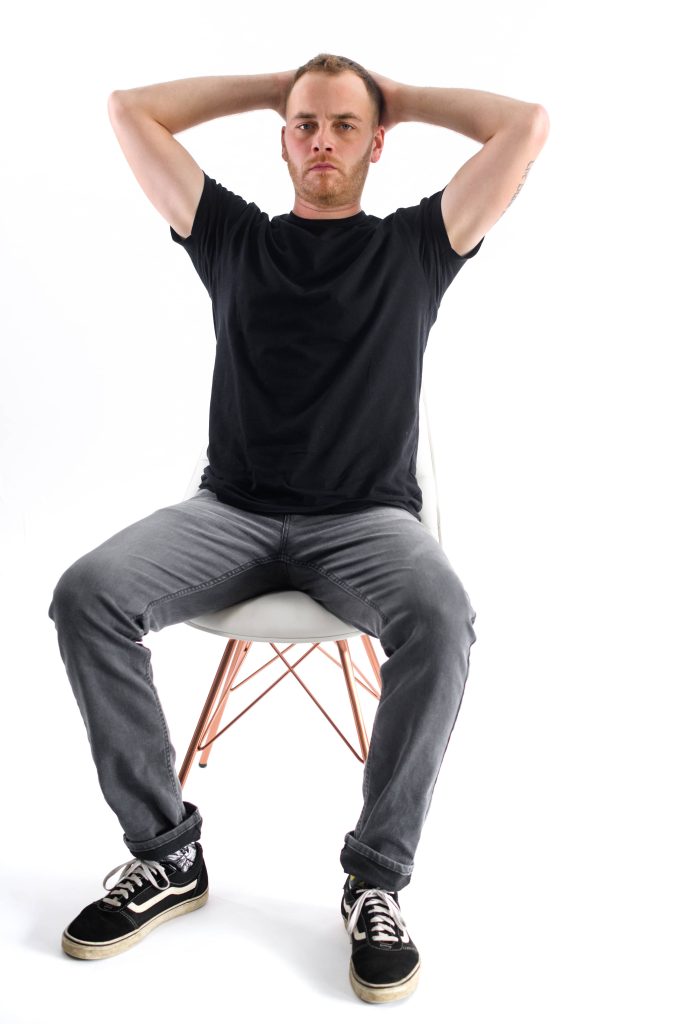
We’ve all seen this before on a crowded subway or park bench:
What it Means: Manspreading is typically a territorial cue done by men signalling dominance. Manspreading shows off the “goods” and is done when someone is feeling relaxed and confident.
It’s rarely done by women because it’s considered unfeminine. Plus, skirts. What happens if a woman tries manspreading?
There’s also a reason behind all the spreading—The Economonitor3https://www.thestreet.com/economonitor/us/manspreading-the-myth-the-math-dude reported that the average male has shoulders 28% wider than his hips, while women have shoulders only 3% wider than the hips. Because of this, men tend to spread their legs wider to incorporate this ratio.
You may even observe one man after another all manspreading next to each other—what gives!? It turns out if one man spreads his legs, other men around him will usually mirror to maintain status unless they are submissive4https://www.amazon.com/Definitive-Book-Body-Language-attitudes/dp/1409168506.
How to Use it: Women will feel uncomfortable by men who manspread, especially in business meetings. If you’re a man making a business deal, avoid manspreading at all costs.
Seated-readiness position

You’re probably very familiar with this cue. You can often find this cue at the end of a presentation or meeting and people are just about to leave their seats.
There are 3 parts to this cue:
- Sitting position
- The forward lean
- One hand on a leg

What it Means: This posture means confidence. Just as the name implies, the seated-readiness position means someone is ready to take action! Whether it’s to get up and leave or to make an important decision, this cue is important especially in negotiations.
The Peases reviewed video clips of salespeople interviewing potential buyers. Whenever someone performed a chin stroke:
- If the seated-readiness position followed… the client said “yes” to the salesperson’s proposal more than 50% of the time.
- But if the client crossed their arms instead… the sale was usually not made.
How to Use it: Take this position at the end of a long meeting or when you want to end a conversation early. This can make you appear action-oriented and enthusiastic, but depending on the context can also make you appear impatient or impolite.
Watch our video below to learn how to read people and decode 7 body language cues:
And there’s a lot more to these cues than the seated-readiness position, too. Do you really want to boost your charisma to the next level? Read one of the most comprehensive science-backed manuals on human behavior.
The leg tuck

This sitting posture is when one leg is tucked under. Not everyone can do it, but those flexible enough may be giving away an interesting tell.
What it Means: People usually tuck their legs in when they’re feeling comfortable. But pay close attention to the knee that is folded underneath. Where it’s pointing is likely the person they are most interested in or have the most chemistry with!
The direction the knee is pointing usually indicates interest.
As a person gets more familiar with someone, their knees may point towards them more and more. Pointing the knees also opens up the torso, making them more open towards them.
For example, take a look at this picture:

Can you tell who she’s interested in the most?
The catapult

So you’re feeling relaxed and want to appear in control, while also remaining superior. Try the catapult.
If you’re seated, you can try it out now—lean back, interlace your fingers behind your head, and stick your elbows out. Now you’re in control!
What it Means: This cue implies an ultra-relaxed attitude and is often used by professionals like accountants, lawyers, and sales managers. Catapulting takes up a huge amount of space (just like the name suggests), and signals high dominance and confidence.
Be careful, though—others may do the catapult to give you a false sense of security, only to use it to ambush you later4https://www.amazon.com/Definitive-Book-Body-Language-attitudes/dp/1409168506.
In a study of one insurance company, the Peases found that 27 out of 30 of the male sales managers used the Catapult position regularly around other salespeople or subordinates, but rarely when around superiors. With their superiors, they were likely to use submissive and subordinate cues instead.
How to Use it: The catapult can be used to show relaxation. But used in the wrong situation, it can also intimidate others, showing off a noncaring attitude.
Use the catapult to stay in control if you’re the boss. But never do it when you’re a subordinate.
Neutral Leg Cues
Onto the neutral cues! These cues depend highly on context and can mean different things.
Be careful when interpreting these cues, as you’ll often need to read other body parts to get a full understanding of what the cue means.
Quiz Time: The Most Common Leg Posture on Late-Night TV
In most late-night talk shows, such as Jimmy Kimmel Live! Or Late Night with Conan O’Brien, women guests will often cross their legs like this:
Src
What does this cue indicate?
1. Convenience
2. Comfort
3. Chemistry
4. All of the Above
Click to Reveal Answer:
The answer is d) all of the above! Women who do this often wear skirts, so they cross their legs to protect their vulnerable bits. They’ll also cross because it’s naturally comfortable, and their knee will usually point towards the host, signalling mutual chemistry.
Crossed legs

Back in the Victorian times, a young girl was bluntly told that a lady never crosses her legs5https://www.amazon.com/Peoplewatching-Desmond-Morris-Guide-Language/dp/0099429780. Nowadays, everyone crosses.
Anne Hathaway crosses her legs:

Nicki Minaj did it on the red carpet:
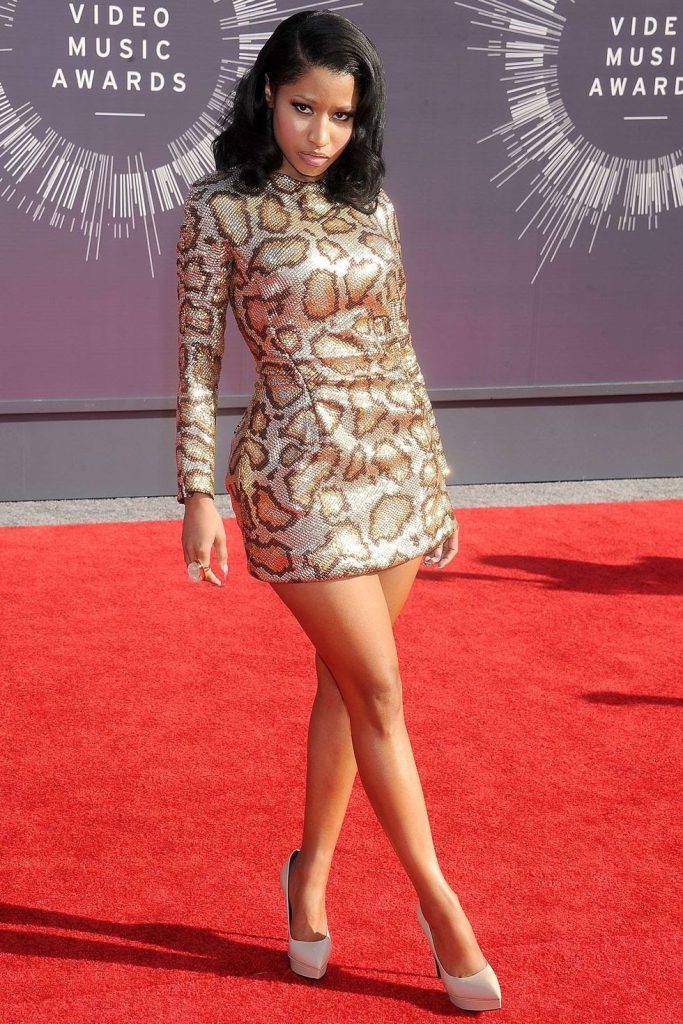
Brad Pitt did it in Ocean’s Eleven:

Here’s me crossing my legs and mirroring in an interview with Chris Paff6https://www.youtube.com/watch?v=EcJ_Ujm0jB4!
What it Means: Most people associate crossed legs with the same negative associations of crossed arms, but they don’t necessarily mean the same thing. There are 5 meanings to crossed legs.
Comfort: We tend to cross our legs when we feel comfortable, confident, and relaxed. For some people this is a naturally comfortable posture, and women who wear short skirts will often cross their legs. Others will cross to shift their weight if their legs are feeling tired.
Chemistry: In some cases, this may mean high interest or attraction. Watch the other person’s knee—usually they will point at someone they like the most.
Threats: On the downside, if someone we don’t like suddenly appears, we might immediately uncross our legs and sit more upright7https://www.amazon.com/What-Every-Body-Saying-Speed-Reading/dp/0061438294. For example, if we are alone in an elevator with our legs crossed and a stranger suddenly comes in, we’ll likely uncross our legs. This is because crossed legs decreases our balance, and we want to be ready when a threat appears.
Ready to Leave: Watch for this cue when someone goes from crossed legs to uncrossed. This can mean they want to leave, especially if they go into the seated-readiness position5https://www.amazon.com/Peoplewatching-Desmond-Morris-Guide-Language/dp/0099429780.
Dislike: Gerard I. Nierenberg and Henry H. Calero, authors of How to Read a Person Like a Book, studied over 2,000 negotiations and found that none of the negotiators had their legs crossed when a deal was made. This is because crossing legs can be a closed-off cue. This body language is also common when someone is new to a group of people. If you see a person standing or sitting with legs crossed, there’s a chance they’re feeling submissive or defensive.
How to Use it: Since people cross for a variety of reasons, the key to reading this cue is to take other body language cues into context. If a person is crossed but smiling with their arms to their side, they may be relaxed. But if they’re crossing legs, crossing their arms, and looking down, they might be feeling negative.
You can also look at how their legs are crossed. If the top leg is crossed over towards the other person, they may be feeling good.
But if the thighs are acting as a barrier, this can be negative and defensive:
The Figure 4
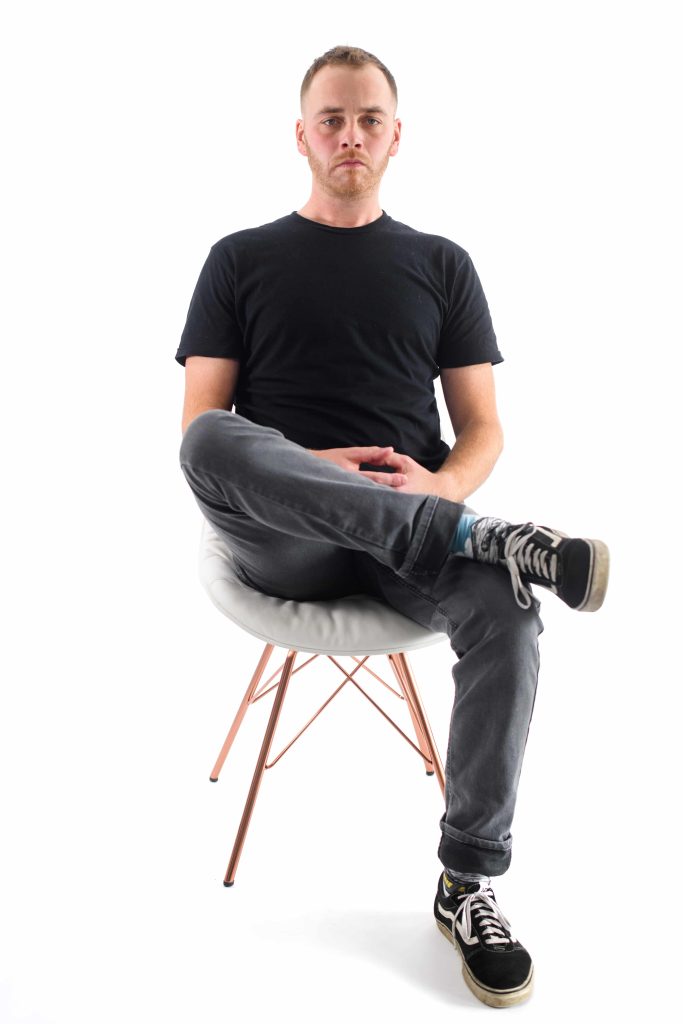
What is the figure 4? It’s a sitting position that looks like the number “4.”
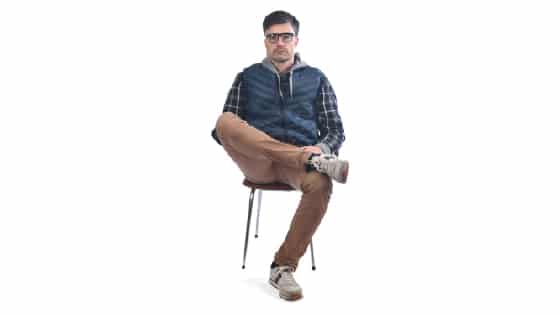
What it Means: The figure 4 isn’t just a sitting position. It’s one of the most dominant sitting positions you can do while also remaining subtle. This is the position Western cowboys sat in. It also displays the family jewels openly and takes up more physical space than sitting in a neutral position or a closed cross, which is a way to claim territory.

It’s also a very American thing to do. In World War 2, Nazis kept on the lookout for the figure 4 sitting position, as this indicated a non-German or someone who likely had American influence.
It can also indicate a person feels argumentative or competitive, such as in Lance Armstrong’s interview with Oprah.
We were all shocked to find out that Lance Armstrong had been involved with illegal substances throughout his seven Tour De France wins. His interview with Oprah, however, showed more anger, pride and defiance than sadness and regret.
Not only are sadness and sorrow missing throughout the interview, but his body actually shows dominance. One key body language cue he showed is the figure 4.

How to Use it: Prop your leg up in the figure 4 if you want to close down or create a barrier between you and the other person. Be careful to do this in parts of the Middle East or Asia, however, as showing the dirty soles of your shoes can be insulting!
Otherwise, keep your feet grounded. Studies show that people make most of their final decisions when both feet are on the ground4https://www.amazon.com/Definitive-Book-Body-Language-attitudes/dp/1409168506. Therefore, the figure 4 is not helpful when trying to make a decision.
Leg clamp

As a variation of the Figure 4, the Leg Clamp happens when someone grabs their bent leg, forming a more structured barrier between them and everyone else. This is a very stubborn and competitive gesture that should only be used to shut people down.
Battle stance
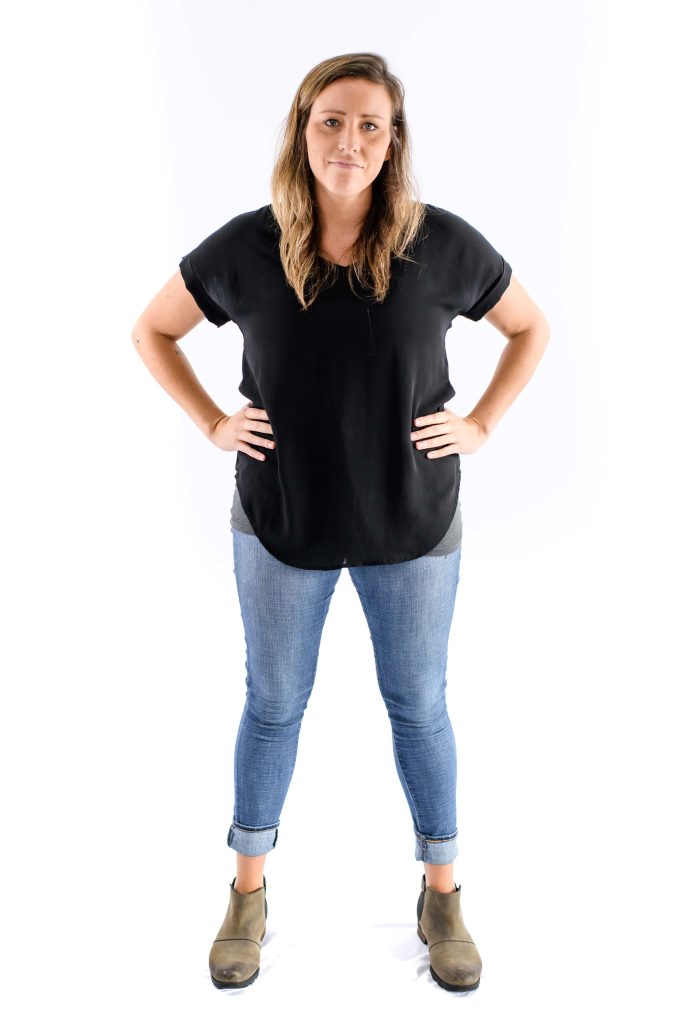
Okay, we’re about to go to battle. Get into positions, ready your feet, and…
Wait a minute! Are your feet spread out wide like mine? We’re in the battle stance!
What it Means: This stance is all about taking up space. Also a male-dominant cue, you’ll usually see wide-spread legs with arms either to the side or crossed.
The next time you see an argument (or are in one yourself!), observe the legs. Chances are, if a person’s legs were close together, they are now far apart. And the further apart they get, the more increasingly unhappy they become.
When 2 people face off, throwing heated words of fire at each other, you will never see their legs crossed.

How to Use it: This move should be used only to establish authority or control unruly individuals, which is why angry teachers will often use it with a classroom full of rowdy kids.
It’s such a dominant move that Navarro even tells law enforcement and executives to avoid using this move if they want to build trust. Even psychopaths have been known to use the battle stance along with eye gaze to control others.
Avoid standing with your legs far apart to avoid confrontation.
If you catch yourself splaying your legs, bring them together to reduce tension or anger immediately.
Soldier stance

The soldier stance is the opposite of the battle stance. Just imagine a soldier with legs together, back straight, and stiff body, and you’ve got the soldier stance.

What it Means: The soldier stance is used in very formal situations and is typical for people who are inferior to a more dominant individual.
Employees do this in front of their boss.
Kids in front of domineering fathers.
And of course, soldiers in front of their superiors.

It can also be a very ‘neutral’ stance for some people. In this case, they may also have neutral feelings and have no commitment to stay or go during a conversation4https://www.amazon.com/Definitive-Book-Body-Language-attitudes/dp/1409168506. You’ll often see women using the solider stance more in female-male interactions as a “no comment” signal.
If you see a girl assuming the soldier stance during a date, it’s a no-go.
In other cases, people who stiffen up suddenly may feel hesitant or nervous, and not in control of a situation. If that’s the case, pay attention to a person’s eyes to see if they widen and watch their mouth to see if it slightly opens. This may indicate they’re feeling scared during a situation.
How to Use it: If you’re feeling overly-anxious/excited/scared/etc. and want to calm your nerves, try assuming the soldier stance. Soldiers do this because it often keeps them calm and level-headed.
Sitting with hands between legs
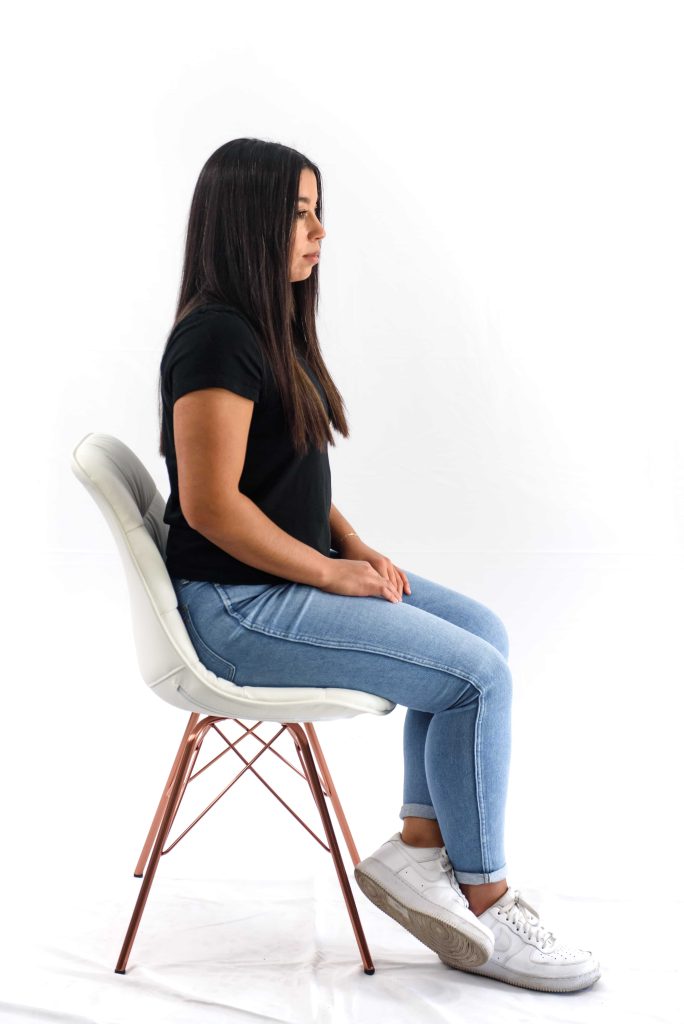

What it Means: Any time the hands are hidden, especially if they’re sandwiched between the legs, this likely signals insecurity or lowered confidence.
- Did a topic come up that the person didn’t like?
- Are they around new people and feeling uncomfortable?
- Is there other dominant individuals around?
All these factors can contribute to hiding hands. However, if the hands are between the legs but in a steepled position, this can mean the complete opposite: confidence.
Hands can mean many different things depending on how they’re used. Learn more in our complete hand body language article here:
20 Hand Gestures You Should Be Using and Their Meaning
Negative Leg Cues
Finally, we have negative leg body language. These cues signal anxiety, stress, and may even indicate lying.
Shaking legs
I’ve seen a LOT of leg shakers in my lifetime, and while many may consider it rude or impolite, leg shaking may actually serve a purpose.
What it Means: Leg shaking can indicate excess energy, nervousness, or boredom.
Excess Energy: Shaking legs signals excess energy and a desire to release that energy somewhere. Most people don’t release by screaming or flailing about wildly, so their extra energy manifests itself in the leg shake.
You’ll see this cue a lot in:
- Long meetings
- School lectures
- The office
- The waiting room at the doctor’s
In large group meetings, there almost always will be one shaker in the group. Shaking is also a great way to relax tight muscles that develop from sitting too long. Or generate some heat in the cold.
Nervousness: Shaking legs is also very common before competitions or sports matches due to nerves. If you observe athletes before they perform, you might see leg shaking as a common body language cue.
Boredom: Did you know leg shaking can increase concentration? Studies show that some children with ADHD perform repetitive movements like leg shaking to help ease boredom so they can concentrate better.
Leg cleansing
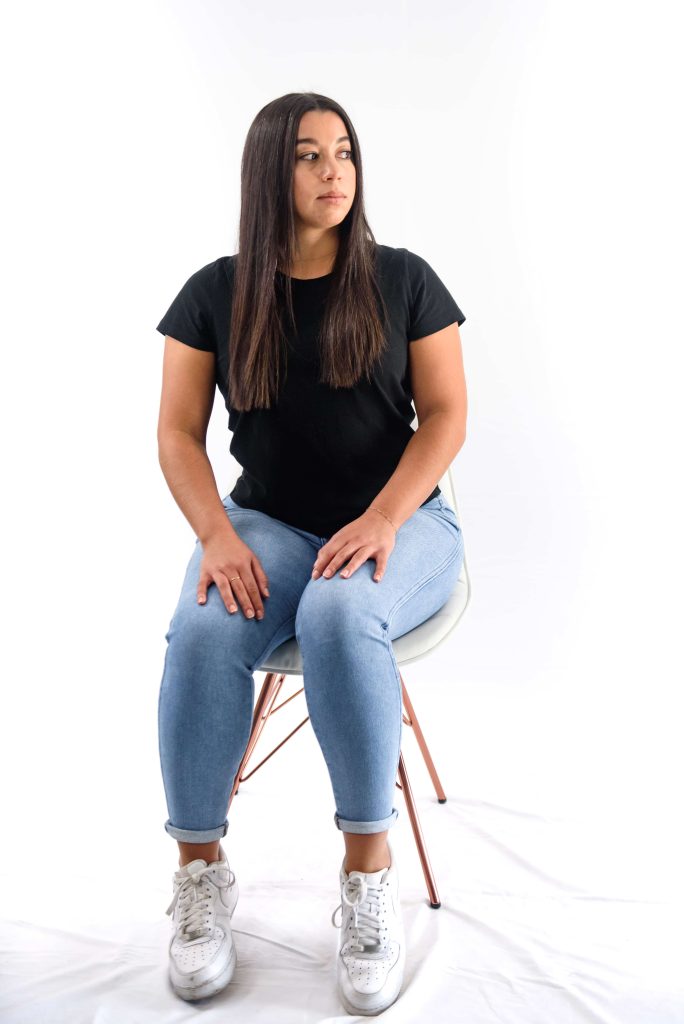
I’m guilty of leg cleansing. Not only cleansing with homemade honey sugar scrubs, but also cleansing when I’m in sticky situations.
What it Means: Leg cleansing is a very significant cue that occurs quickly in reaction to a negative event7https://www.amazon.com/What-Every-Body-Saying-Speed-Reading/dp/0061438294. Navarro observed this cue for years whenever suspects are presented with conclusive evidence.
Sometimes the leg cleanse is only done once. But it can also be done repeatedly when someone needs extra reassurance, and also increases in intensity when stress increases.. Whenever we cleanse, it serves 2 purposes:
- Dries any sweat build up on our hands
- Pacifies us through tactile stroking
If a table is present, you can still see signs of cleansing. Pay close attention to simultaneous movement of the upper arm and shoulder.
When you see signs of leg cleansing, it can be an indicator of lying. However, it can just mean the person is nervous, so be careful not to misjudge this cue.
Touching legs

Leg touching comes in many forms:
- The leg scratch
- The leg rub
- Leg poking
- Pinching
- Smoothing out pants or skirt
What it Means: In most cases, it means the same: discomfort.
Leg touching in all forms is a common sign of discomfort.
When you see leg touching repeatedly, such as self-massaging the legs or repeating the same gesture, this can indicate high stress. We often “massage” ourselves or provide repetitive stimulation in order to calm our nerves down.
Ankle scratching

Have you ever seen someone scratch their ankles? I remember one time I saw a business partner giving updates about her potential lead. She ankle scratched, and needless to say wasn’t too happy with the outcome.
What it Means: During tense situations, scratching the ankle relieves stress and even helps ventilate the skin when pants or socks are lifted8https://www.amazon.com/Dictionary-Body-Language-Field-Behavior-ebook/dp/B075JDX981.
But sometimes our ankles just get itchy. And conveniently enough, researchers found out that the ankle scratch is the King of all scratches. In other words, scratching the ankle gives the most pleasure9https://onlinelibrary.wiley.com/doi/abs/10.1111/j.1365-2133.2012.10826.x when compared to scratching the forearm or back.
So if you see an ankle scratch, be careful not to confuse it with just a normal itch!
Little girl legs

Little girls often have this posture they do whenever they get into trouble. I’ve noticed it a lot in my daughter, Sienna!
Here’s what they’ll do:
- They’ll take one leg and cross it over
- Their forward foot will lift off the ground, creating imbalance

What it Means: This is NOT a great posture to use, especially on stage. In my past trainings, I’ve seen this cue used many times. But the thing is it strips women of their confidence! Not only are they not firmly planted on the floor, the wobbliness of this posture makes their words sound less powerful.
How to Avoid it: Catch yourself with little girl legs? Immediately uncross and firmly plant your feet on the ground. You may even notice your voice sounding more powerful and confident than before!
Want to sound even MORE powerful? Here are my best tips I use before giving presentations:
5 Vocal Warm Ups Before Meetings, Speeches and Presentations
Sticky legs
I call this cue sticky legs. This happens when you just can’t get your legs apart, and they remain close together for a long time.
What it Means: Similar with the soldier stance, if someone sits with sticky legs, it often means insecurity.
Confidence is revealed by how we sit.
Since sticky legs reduces the amount of space we take up, you might even notice crossed arms or slumped shoulders along with this gesture.
Women may also do this out of social convention7https://www.amazon.com/What-Every-Body-Saying-Speed-Reading/dp/0061438294 or for comfort, but it usually means insecurity or low confidence if the legs are stuck together longer than usual.
Buttress stance

If you don’t know what a buttress is, it’s that piece of wall sticking out of castles used as support.
Similarly, people sometimes look like a buttress by keeping their back leg straight and shifting their body weight back with the front leg bent.
What it Means: The Buttress stance, according to Elizabeth Kuhnke10https://www.amazon.com/Body-Language-Dummies-Elizabeth-Kuhnke/dp/1119953510, indicates that a person is ready to leave. The shift to the back of their leg is opposite of the forward lean and signals they want an exit to the conversation.
How to Use it: Shift to the back of your leg, cross your arms, and turn your torso away if you want to end a conversation.
Bonus cue: Jazz legs

Have you heard about the new photogenic pose that’s going viral11https://www.dailymail.co.uk/femail/article-8467853/Fashion-forward-celebs-try-Jazz-legs-pose-Instagram.html? It’s called Jazz Legs. This pose is similar to the Buttress Stance, with the weight shifted to the back leg. Except the back leg is bent and the front leg is kept straight.
It looks something like this:

Talk about a bold leg pose!
The truth is, there are many different leg postures and poses. And with this knowledge, I hope you can break the chains holding you back in all your social endeavors!
Here’s my challenge for you: The next time you’re in a conversation, try paying attention to the legs instead of the face. What are the legs telling you?
The next step is to expand your body language knowledge with one of our other articles…
- Feet Body Language – 18 Cues You Should Know
- How to Read Body Language
- Why Body Language is Important
- How to Build Rapport with Body Language
Crack The Code on Facial Expressions
The human face is constantly sending signals, and we use it to understand the person’s intentions when we speak to them.
In Decode, we dive deep into these microexpressions to teach you how to instantly pick up on them and understand the meaning behind what is said to you.
Don’t spend another day living in the dark.
To your success,
Vanessa
Side Note: As much as possible we tried to use academic research or expert opinion for this master body language guide. Occasionally, when we could not find research we include anecdotes that are helpful. As more research comes out on nonverbal behavior we will be sure to add it!
This article is part of our body language guide. Click here for more.
Article sources
- https://www.nytimes.com/1970/05/31/archives/the-way-we-speak-body-language-the-way-we-speak-body-language.html
- www.amazon.com/Definitive-Book-Body-Language-attitudes/dp/140916850
- https://www.thestreet.com/economonitor/us/manspreading-the-myth-the-math-dude
- https://www.amazon.com/Definitive-Book-Body-Language-attitudes/dp/1409168506
- https://www.amazon.com/Peoplewatching-Desmond-Morris-Guide-Language/dp/0099429780
- https://www.youtube.com/watch?v=EcJ_Ujm0jB4
- https://www.amazon.com/What-Every-Body-Saying-Speed-Reading/dp/0061438294
- https://www.amazon.com/Dictionary-Body-Language-Field-Behavior-ebook/dp/B075JDX981
- https://onlinelibrary.wiley.com/doi/abs/10.1111/j.1365-2133.2012.10826.x
- https://www.amazon.com/Body-Language-Dummies-Elizabeth-Kuhnke/dp/1119953510
- https://www.dailymail.co.uk/femail/article-8467853/Fashion-forward-celebs-try-Jazz-legs-pose-Instagram.html
16 thoughts on “20 Leg Body Language Cues To Help You Analyze ANY Situation”
Comments are closed.
How to Deal with Difficult People at Work
Do you have a difficult boss? Colleague? Client? Learn how to transform your difficult relationship.
I’ll show you my science-based approach to building a strong, productive relationship with even the most difficult people.

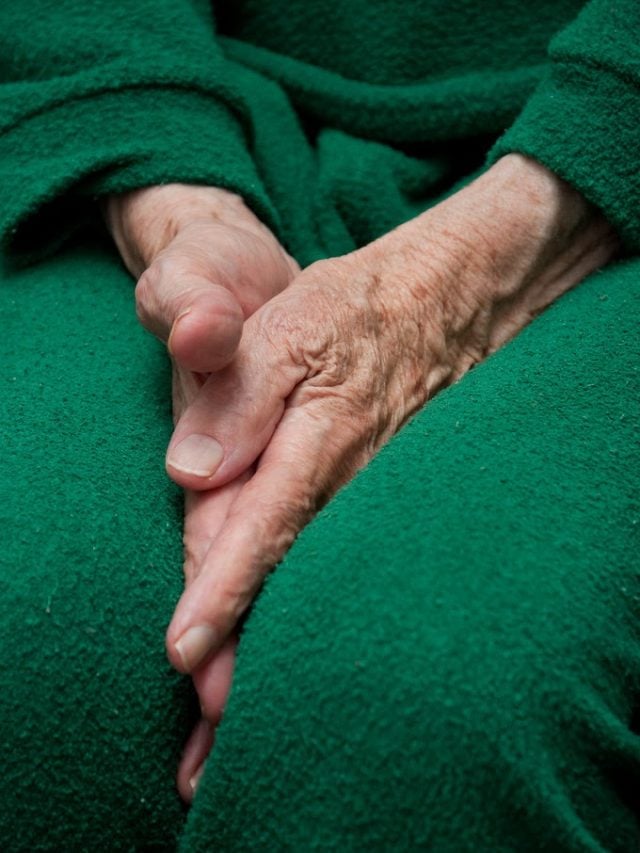
Hi Vanessa,
Thanks so much for posting this inspirational post as always- I learn something new from you every day.
I just wanted to ask if you would know what a men are spreading sitting with both palms down touched on both legs mean?
Hi, Tracey!
This is typically a relaxed posture and it could mean they are simply resting their upper torso by leaning their arms on their legs. If they are leaning forward, it could mean they are in a ready position and want to leave. The key here is paying attention to the rest of their body to see what they’re really feeling! Hope this helps. Rob | Science of People Team
Hi Vanessa,
Thanks so much for posting this inspirational post as always- I learn something new from you every day.
I just wanted to ask if you would know what a men are spreading sitting with both palms down touched on both legs mean?
Hi, Tracey!
This is typically a relaxed posture and it could mean they are simply resting their upper torso by leaning their arms on their legs. If they are leaning forward, it could mean they are in a ready position and want to leave. The key here is paying attention to the rest of their body to see what they’re really feeling! Hope this helps. Rob | Science of People Team
Hi Vanessa,
Thanks so much for posting this inspirational post as always- I learn something new from you every day.
I just wanted to ask if you would know what a men are spreading sitting with both palms down touched on both legs mean?
Hi, Tracey!
This is typically a relaxed posture and it could mean they are simply resting their upper torso by leaning their arms on their legs. If they are leaning forward, it could mean they are in a ready position and want to leave. The key here is paying attention to the rest of their body to see what they’re really feeling! Hope this helps. Rob | Science of People Team
Hi Vanessa,
Thanks so much for posting this inspirational post as always- I learn something new from you every day.
I just wanted to ask if you would know what a men are spreading sitting with both palms down touched on both legs mean?
Hi, Tracey!
This is typically a relaxed posture and it could mean they are simply resting their upper torso by leaning their arms on their legs. If they are leaning forward, it could mean they are in a ready position and want to leave. The key here is paying attention to the rest of their body to see what they’re really feeling! Hope this helps. Rob | Science of People Team
Wow!!so nice n lovely 😘😘😘
Wow!!so nice n lovely 😘😘😘
Wow!!so nice n lovely 😘😘😘
Wow!!so nice n lovely 😘😘😘
I like that very much, my mother could read n feel people energy,that’s something I also have, so this is very interesting to me.
I like that very much, my mother could read n feel people energy,that’s something I also have, so this is very interesting to me.
I like that very much, my mother could read n feel people energy,that’s something I also have, so this is very interesting to me.
I like that very much, my mother could read n feel people energy,that’s something I also have, so this is very interesting to me.